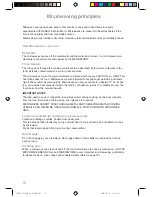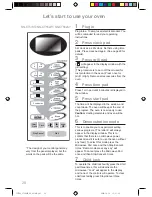
16
5.
Foods with skins.
Potatoes, apples, egg yolk, whole vegetables and sausages are examples of food with non
porous skins. These must be pierced using a fork before cooking to prevent bursting.
6.
Liquids.
Liquids and other foods must not be heated in sealed containers since they are liable to
explode. When heating liquids, eg soup, sauces and beverages in your microwave
oven, overheating the liquid beyond boiling point can occur without evidence of bubbling.
This could result in a sudden boil over of the hot liquid. To prevent this possibility
the following steps should be taken:
a)
Avoid using straight-sided containers with narrow necks.
b)
Do not overheat.
c)
Stir the liquid before placing the container in the oven and again halfway through the
heating time.
d)
After heating, allow to stand in the oven for a short time, stirring again before carefully
removing the container.
e)
Microwave heating of beverages can result in delayed eruptive boiling, therefore care
should be taken when handling the container.
7.
Lids.
Always remove the lids of jars and containers and takeaway food containers before you
microwave them. If you don’t then steam and pressure might build up inside and cause an
explosion even after the microwave cooking has stopped.
8.
Deep fat frying.
Do not attempt to deep fat fry in your oven.
9.
Meat thermometer.
Use a meat thermometer to check the degree of cooking of roasts and poultry only when
meat has been removed from the microwave. If undercooked, return to the oven and cook
for a few more minutes at the recommended power level. Do not leave a conventional meat
thermometer in the oven when microwaving.
10.
Paper, plastic.
When heating food in plastic or paper containers, keep an eye on the oven due to the
possibility of ignition. Do not use wire twist-ties with roasting bags as arcing will occur.
Do not use re-cycled paper products, e.g. kitchen roll unless they say they are specifically
designed for use in a microwave oven. These products contain impurities which may cause
sparks and/or fires when used.
11.
Reheating.
It is essential that reheated food is served “piping hot”.
Remove the food from the oven and check that it is “piping hot”, i.e. steam is being emitted
from all parts and any sauce is bubbling. (If you wish you may choose to check the food has
reached 72˚C with a food thermometer
– but remember do not use this thermometer inside
the microwave.)
For foods that cannot be stirred, e.g. lasagne, shepherds pie, the centre should be cut with a
knife to test it is well heated through. Even if a manufacturer’s packet instructions have been
followed always check the food is piping hot before serving and if in doubt return your food to
the oven for further heating.
Important Information – read carefully
IP2784_37X60BP_00_091016.pdf 12
2009-10-16 15:41:41
















































